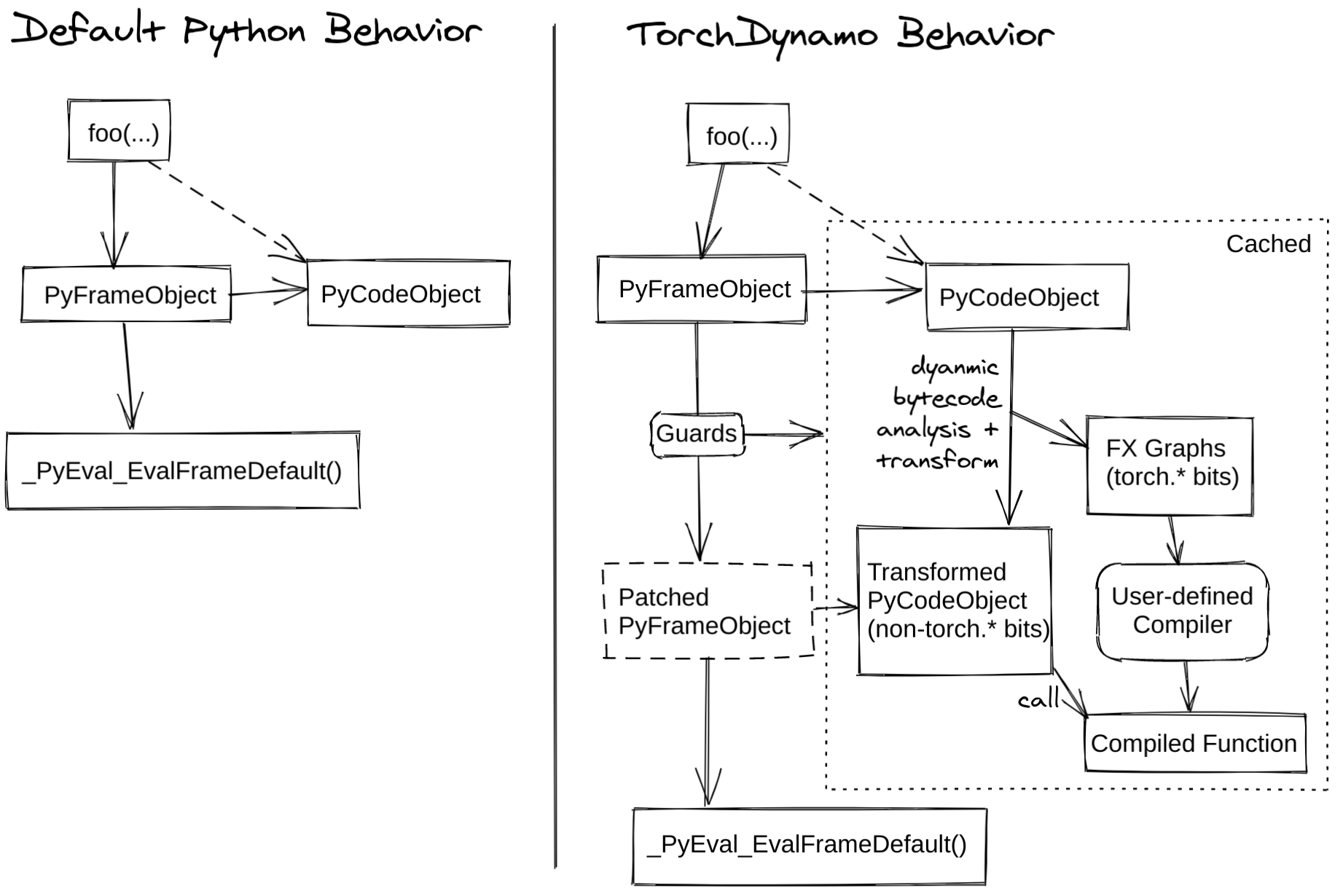This is an early experiment into using PEP 523 to expose fusion opportunities in PyTorch. It dynamically rewrites Python bytecode in order to extract sequences of PyTorch operations into an FX Graph which is just in time compiled with a user-defined compiler. It creates this FX Graph through bytecode analysis, and is designed to generating smaller graph fragments that can be mixed with Python execution. The name is a reference/homage to DynamoRIO, which dynamically translates machine code.
For more information see progress updates posted on dev-discuss.pytorch.org:
- TorchDynamo: An Experiment in Dynamic Python Bytecode Transformation
- TorchDynamo Update: 1.48x geomean speedup on TorchBench CPU Inference
Python 3.8 is highly recommended. Python 3.7 works, but is only sporadically tested and has lower coverage. Other python versions are untested.
For running TorchBench, use the fork found here. This contains a few minor fixes that have not yet been merged upstream.
git clone git@github.com:jansel/benchmark.git torchbenchmark
cd torchbenchmark
env PYTHON_VERSION=3.8 ./scripts/recreate_conda_environment.sh
cd ..
git clone git@github.com:jansel/torchdynamo.git
cd torchdynamo
conda activate torchbenchmark
pip3 install torch tabulate
make setup
python setup.py develop # compiles C/C++ extension
pytest # run tests
Run all tests with:
conda activate torchbenchmark # if not activated already
make test
Run all torchbench models with:
conda activate torchbenchmark # if not activated already
make torchbench
The torchbench.py script contains many options for working with torchbench models:
./torchbench.pywill measure operator coverage./torchbench.py --overheadwill measure overheads (without doing any optimizations)- see
./torchbench.py --helpfor options
Tests set torchdynamo.config.debug = True, which triggers useful printouts if you add the -vs option when running tests.
For example, to look deeper into what this test is doing:
@make_test
def test_viatorch(a, b):
return torch.sub(a, b)
run it with:
python setup.py develop && pytest -vsk test_viatorch
which prints out:
...
fx.symbolic_trace graph:
opcode name target args kwargs
------------- ------ ------------------------------------------------------ ------ --------
placeholder a a () {}
placeholder b b () {}
call_function sub <built-in method sub of type object at 0x7f4e1b80f920> (a, b) {}
output output output (sub,) {}
__compiled_fn_0
opcode name target args kwargs
------------- ------ ------------------------------------------------------ ---------- --------
placeholder a_0 a_0 () {}
placeholder b_1 b_1 () {}
call_function sub <built-in method sub of type object at 0x7f4e1b80f920> (a_0, b_1) {}
output output output (sub,) {}
ORIGINAL BYTECODE
116 0 LOAD_GLOBAL 0 (torch)
2 LOAD_METHOD 1 (sub)
4 LOAD_FAST 0 (a)
6 LOAD_FAST 1 (b)
8 CALL_METHOD 2
10 RETURN_VALUE
MODIFIED BYTECODE
114 0 LOAD_GLOBAL 2 (__compiled_fn_0)
2 LOAD_FAST 0 (a)
4 LOAD_FAST 1 (b)
6 CALL_FUNCTION 2
8 RETURN_VALUE
GUARDS:
- local 'a' TYPE_MATCH
- local 'b' TYPE_MATCH
- global 'torch' FUNCTION_MATCH
this output contains:
- The FX graph captured by
fx.symbolic_trace()(for baseline comparison) - The FX graph generated by TorchDynamo
- The Python bytecode of the original function
- The modified Python bytecode generated by TorchDynamo
- The guards generated to check if the generated code is valid
A useful (test driven development) workflow when adding a feature is:
- Add a test for the behavior you want to add
- Run the test with
pytest -vsk <test_name> - Fix issues
- Go to step 2
This project is auto-formatted with black and clang-format.
pip install flake8 blackfirst, then:make formatto reformat all filesmake lintto run linters
